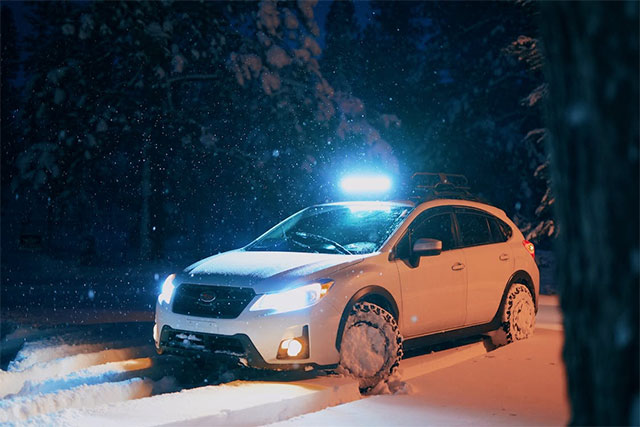You might like winter. But your car? Not so much.
The cold weather can take a toll on your vehicle, causing all sorts of problems. But there are a few things you can do to help your car weather the winter months.
In this article, we’ll discuss everything you need to do to prepare your car for shorter days and longer nights.

Table of Contents
1. Get comprehensive car coverage
If you live in an area where snow storms or flooding are common, the first thing you want to do is make sure you have comprehensive car insurance. This type of coverage will cover the unexpected and protect you from damages caused by weather events, as well as theft and vandalism.
If you don’t have comprehensive coverage, now is the time to add it to your policy. You can typically do this by contacting your car insurance company or agent. If your area has low theft and vandalism rates and you don’t want to pay for comprehensive car coverage, ask your insurer about other options, such as isolated natural disaster car coverage (if that’s available).
2. Check your battery
One of the most common problems in winter is a dead battery. The cold weather can make it harder for your battery to start your car. And if you live in an area where snow and ice are common, the build-up of these materials on your car can also lead to battery problems.
That’s why it’s important to have your battery checked before winter sets in. You can typically do this at your local auto parts store or dealership. If your battery is more than three years old, it’s a good idea to replace it before winter.
If you’re comfortable doing it, you can also check your battery yourself. First, make sure the terminals are clean. Then, use a voltmeter to test the battery voltage. The voltage should be between 12.4 and 14 volts. If it’s lower than that, you should recharge or replace your battery.
If you’re not comfortable doing this yourself, ask a friend or family member who is. Or, take your car to a mechanic or dealership and have them do it for you.
3. Keep your gas tank full
In the winter, you want to make sure your gas tank is always full. This will help prevent your gas lines from freezing.
It’s also a good idea to keep a spare can of gas in your garage. That way, if you do run out of gas, you can quickly fill up your tank and get back on the road.
4. Change your oil
You should also change your oil before winter sets in. This will help your engine run smoothly and prevent problems caused by the cold weather.
If you’re not sure how to change your oil, there are plenty of helpful videos online that can walk you through the process. Or, you can take your car to a mechanic and have them do it for you.
Just make sure you use the right oil for your car. You can typically find this information in your owner’s manual or online.
5. Check your wiper blades
Your wiper blades play a crucial role in keeping your windshield clear in the winter. That’s why it’s important to check them before the cold weather sets in.
If your wiper blades are more than six months old, it’s a good idea to replace them. You can typically do this at your local auto parts store or dealership. But it’s better to do it yourself because it’s not too complex.
To replace your wiper blades, first, lift the windshield wipers up from the windshield. Then, remove the old wiper blades and snap on the new ones. Make sure they’re securely in place before you lower the windshield wipers back down.
6. Consider getting winter tires
If you live in an area where snow and ice are common, you should seriously consider getting winter tires. Winter tires are designed to provide better traction in cold weather and on icy roads. And they can make a big difference in your safety while driving in the winter.
If you decide to get winter tires, make sure you get them installed before the first snowfall. That way, you’ll be prepared for whatever the winter weather throws your way.
You should also consider getting a set of tire chains. Tire chains can help give you extra traction on icy roads. They’re typically only necessary in very snowy or mountainous areas. But if you live in such an area, they’re a good idea to have on hand.
7. Verify tire fitness
If you don’t want to buy winter tires, you should at least check and confirm that your current tires are fit for cold weather and slippery roads. To do this, you can check the tread depth and tire pressure.
Tread depth is the measure of how much tread is left on your tires. The deeper the tread, the better the traction. You can check your tread depth with a tread depth gauge (or do a penny test as explained here). Experts recommend that you replace your tires when the tread depth gets down to 4/32 of an inch.
Tire pressure is also important for traction. In the winter, cold weather can cause your tires to lose pressure. That’s why it’s important to check your tire pressure frequently and inflate your tires as needed.
You can check your tire pressure with a tire pressure gauge. Most gauges are relatively inexpensive and easy to use. Make sure your tires maintain a pressure of 30-32 psi.
8. Add antifreeze to your engine coolant
Last but not least, you should add antifreeze to your engine coolant. This will help prevent your engine from freezing when the temperature drops below zero.
When filling up your engine coolant, it’s recommended that you mix equal parts water and antifreeze. This will give you the optimal protection against freezing.
Also, make sure to check your owner’s manual for the correct type of antifreeze to use in your car. Some antifreezes are not compatible with all types of engines.
Once you’ve added antifreeze to your engine coolant, be sure to check the level frequently. This will help ensure that your engine always has enough antifreeze and doesn’t freeze in the winter.













